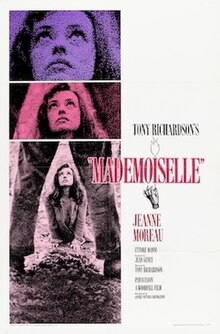Mademoiselle (1966 film)
| Mademoiselle | |
|---|---|
 Theatrical release poster | |
| Directed by | Tony Richardson |
| Written by | Marguerite Duras Jean Genet |
| Produced by | Oscar Lewenstein |
| Starring | Jeanne Moreau Ettore Manni Keith Skinner |
| Cinematography | David Watkin |
| Edited by | Antony Gibbs Sophie Coussein |
| Music by | Antoine Duhamel |
Production companies | Woodfall Film Productions Procinex |
| Distributed by | United Artists |
Release dates | |
Running time | 105 minutes |
| Countries | United Kingdom France |
| Languages | French Italian |
| Box office | $575,000[2] |
Mademoiselle is a 1966 psychological thriller film directed by Tony Richardson. Jeanne Moreau plays the title character, a seemingly-respectable schoolteacher in a small French village, who is actually an undetected sociopath.[3]
A British and French co-production, the film was nominated for the Palme d’Or at the 1966 Cannes Film Festival, and was released theatrically in France on June 3, 1966. It won a BAFTA Award for Best Costume Design (for Jocelyn Rickards).[4]
Plot
[edit]The schoolteacher of a small Corrèze village, only ever referred to by her honorific ‘Mademoiselle’, is an undetected sociopath, engaging in various acts of sabotage and arsonism. She has no apparent motivation, no known cause for revenge, and acquires no material gain or increased standing in the community from her furtive crimes, seemingly acting only out of repressed impulse.
Out of pure prejudice, an Italian woodcutter named Manou becomes the chief suspect of the Mademoiselle's crimes. Sexual tension arises between the two during a series of encounters in the forest. In the meantime, Manou's son Bruno develops a crush on Mademoiselle, his school teacher, but she repeatedly humiliates him in class.
Finally, after a night of somewhat perverse intimacy between Mademoiselle and Manou in the fields, she falsely denounces him and the villagers hack him to death.
In the final scene, as Mademoiselle is leaving the village forever, it is made obvious that Bruno knows her secret.
Cast
[edit]- Jeanne Moreau as ‘Mademoiselle’
- Ettore Manni as Manou
- Keith Skinner as Bruno
- Umberto Orsini as Antonio
- Georges Aubert as René
- Jane Beretta as Annett
- Paul Barge as Young Policeman
- Pierre Collet as Marcel
- Gérard Darrieu as Boulet
- Jean Gras as Roger
- Gabriel Gobin as Police Sergeant
- Rosine Luguet as Lisa
- Antoine Marin as Armand
- Georges Douking as the Priest
- Jacques Monod as the Mayor
Production
[edit]Development
[edit]The original script was written by French writers Jean Genet and Marguerite Duras as a vehicle for actress Anouk Aimée, to be directed by Georges Franju. When Franju dropped out, the script was given by Genet's friend Jeanne Moreau to British director Tony Richardson.
Casting
[edit]Though Richardson always envisioned Jeanne Moreau as the lead, Jean Genet was opposed to it. Writing for the British Film Institute, critic Alex Ramon wrote that “the actress seems central to the film’s tone and aesthetic in many ways.”[3]
Richardson originally wanted Marlon Brando for the role of Manou, but scheduling could not be arranged.[3]
Filming
[edit]The film was shot on location in and around the tiny village of Le Rat, in the Corrèze département of central France. The entire production team stayed in what accommodation they could find locally for the duration of the shoot.
During filming, Richardson had an affair with Jeanne Moreau, and he would divorce his wife Vanessa Redgrave a year after its release.[3]
Release
[edit]The film premiered at the 1966 Cannes Film Festival, where it competed for the Palme d'Or, but lost to the tying The Birds, the Bees and the Italians and A Man and a Woman.[5] It was released in France by United Artists on June 3, and in the United Kingdom on January 12 of the following year.
Home media
[edit]The film was released on VHS and DVD by MGM Home Entertainment in the United States in 1994 and 2002 respectively.
Reception
[edit]The film received mixed reviews from critics.[3] Roger Ebert of the Chicago Sun-Times criticized the film as "murky, disjointed and unbearably tedious," while praising Moreau's performance and the visuals. He called Genet's script "like something out of Evergreen Review by way of French pornography."[6]
Writing for the British Film Institute, Alex Ramon called it "a unique work in Richardson’s canon, made at the time of several ambitious, much-panned projects, this oneiric evocation of destruction and desire feels fresh."[3]
Director Richard Lester praised David Watkin's cinematography, calling it "the most beautiful black and white film I have ever, ever seen."[3]
Awards and nominations
[edit]| Ceremony | Category | Nominee | Result |
|---|---|---|---|
| 1966 Cannes Film Festival | Palme d'Or | Tony Richardson | Nominated |
| 21st British Academy Film Awards[4] | Best British Costume Design (B&W) | Jocelyn Rickards | Nominated |
| Best Cinematography (B&W) | David Watkin | Nominated |
References
[edit]- ^ "IMDB: Mademoiselle (1966) - Release dates". Retrieved 21 March 2010.
- ^ Tino Balio, United Artists: The Company That Changed the Film Industry, University of Wisconsin Press, 1987 p. 246
- ^ a b c d e f g "Destruction and desire: Jeanne Moreau opens the floodgates in Tony Richardson's Mademoiselle". BFI. 24 October 2020. Retrieved 4 August 2024.
- ^ a b "Film in 1966 | BAFTA Awards". awards.bafta.org. Retrieved 4 August 2024.
- ^ "Festival de Cannes: Mademoiselle". festival-cannes.com. Retrieved 8 March 2009.
- ^ Ebert, Roger. "Mademoiselle (1967)". www.rogerebert.com/. Retrieved 4 August 2024.
External links
[edit]- 1966 films
- British black-and-white films
- 1966 romantic drama films
- French independent films
- BAFTA winners (films)
- Films directed by Tony Richardson
- British independent films
- British drama films
- 1960s British films
- 1960s French films
- British psychological thriller films
- French psychological thriller films
- 1960s French-language films
- French black-and-white films
